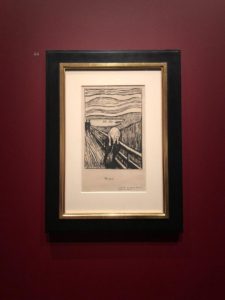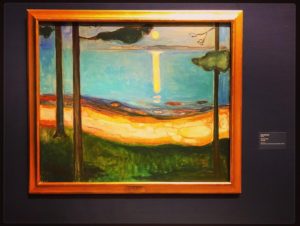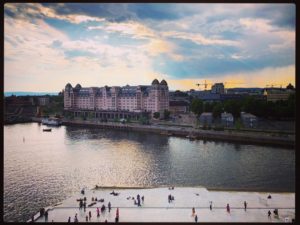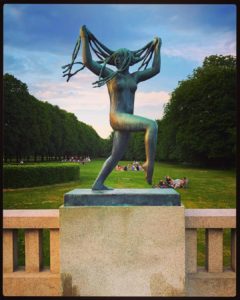Oslo: Nesbo, Munch, Music, Opera & More
Last year, a devastating earthquake shook Oslo. Built only a decade prior, the Opera House was one of the many buildings seriously damaged by the seismic activity. As the Norwegian capital’s skyline collapsed like a house of cards, only the Radisson Blu Plaza Hotel stood tall. Also known as Oslo Plaza, this is not only the tallest building in the city, but also the second tallest in Norway (Trondheim’s Tyholttårnet is the tallest in the country). It is also where an elderly assassin positioned himself on 17 May 2000 in an unsuccessful attempt to assassinate Norway’s Crown Prince on the Norwegian Constitution Day.
Gladly, life in the Scandinavian city is neither as dramatic nor as dangerous as portrayed in the 2018 scandisaster film ‘The Quake’ (‘Skjelvet’ in Norwegian) or Jo Nesbø’s 2000 crime novel The Redbreast (Rødstrupe).
So far, I’ve visited Oslo twice: once in 1998 and then in 2018. Here are my top 8 tips:
8 tips for Oslo
-
Up, close and personal with Munch
Crime author Jo Nesbø, music composer Edvard Grieg and painter Edvard Munch are probably three of the most famous Norwegians. Let’s get to know Munch first.

Start at the Nasjonalgalleriet (National Gallery) on Universitetsgata (off Karl Johans gate, Oslo’s main street). This is home to the most famous of the two painted versions of ‘The Scream’, Munch’s iconic masterpiece. Nasjonalgalleriet also houses Norway’s largest public collection of paintings, drawings and sculptures, including works by the lesser-known Norwegian painters J.C. Dahl and Thomas Fearnley. I would recommend spending 1 to 2 hours there. At the weekends, it opens at 11.00 at the weekends (10.00 on weekdays) and closes at 17.00 (18.00 on weekdays). It is closed on Mondays (admission NOK 120).

Another painted version of the screaming figure is located at the Munchmuseet on Tøyengata. This is also home to more than half of Edvard Munch’s paintings (open every day 10.00-17.00, admission NOK 120).
A new Munch Museum, due to open in 2020, is currently being built next to the Opera House at the head of Oslofjord.
-
Listen to Norwegian music
Who comes to mind when you think of Norwegian musicians? It could be Edvard Grieg, the most famous Norwegian composer, closer associated to Bergen than Oslo (my post on Bergen will be published on 11 May 2019). Perhaps it is soprano Sissel Kyrkjebø, a-ha, Röyksopp, or Alexander Rybak, who won the Eurovision Song Contest in 2009. Or, it could be Kygo and Alan Walker, whose tropical house beats have recently taken Europe by storm. For me, there’s also Norway’s thriving jazz scene. Every year from May to August, when the days just don’t turn into nights, no less than 10 festivals take place across the country.
The Oslo Jazz Festival
Oslo Jazz Festival is held in August when the city enjoys 16 hours of daylight and 8 hours of twilight. This year it takes place between the 11th and the 17th of August and it features a large number of Norwegian and international bands and artists. There are several concerts each day from 18.00 till late; on Saturday the 18thof August, there are concerts from as early as 12.30. It takes place at various venues around the city: the Opera House, Oslo Konserthus (Concert House) (very close to the Royal Palace), Rockefeller Music Hall (also in the city center), Nasjonal Jazzscene Victoria and Universitetets Aula (both on Karl Johans gate). You can buy day passes or tickets for individual concerts.
If you visit Oslo at a different time, go to Blå, a music venue on Brenneriveien in Grünerløkka, where you can listen to indie, rock and jazz bands, or live DJ sets (NOK 120-350). Most concerts start at 19.00 or 20.00; however, on Sundays, the Frank Znort Quartet plays at 16.00 (free admission).
If jazz is not your cup of tea, there’s Øyafestivalen at Tøyenparken. This year it takes place between the 6th and the 10th of August and the line-up includes Norwegian (Sigrid) and international artists, such as the Swedish Robyn, the Australian Tame Impala, the French Christine and the Queens, and the British James Blake.
-
Go to the Opera
Then, there’s also the Oslo Opera House, which gladly still stands tall at the head of Oslofjord (Oslofjorden in Norwegian). This architectural masterpiece is undoubtedly the jewel in the crown of the Norwegian capital. Wander around the building, then walk up onto the roof, and finally enter the foyer, which houses a café and a restaurant. Ticket prices for opera or ballet performances vary starting from as little as NOK 100.

-
Stroll around the sculptures
Today is the International Sculpture Day. Celebrated on the last Saturday of April every year, the International Sculpture Day was established to raise awareness, appreciation and enjoyment of sculpture in communities across the globe.
Frognerparken, also referred to as Vigelandsparken (Vigeland Sculpture Park) is the perfect spot for a picnic or a leisurely walk. Stroll around and admire the 212 bronze and granite sculptures by the Norwegian Gustav Vigeland. The sculptures consist of naked human figures, in various poses and situations. At the highest point lies the Monolith, the centerpiece of the park, composed of 121 human figures rising towards the sky. The park is a nice 25-minute walk from the Royal Palace. Walk on Colbjørnsens gate and then on Gyldenløves gate. On your way there, you will walk past two beautiful bakeries/cafés, Åpent bakeri (Inkognito Terrasse 1) and W.B. Samson (Gyldenløves gate 6). Mocca Kaffebar & Brenneri is also close by (Niels Juels gate 70). If you don’t want to walk to the park, you can take the tram 12.

There are also the Tjuvholmen Sculpture Park and the Ekebergparken Sculpture Park. The former is close to Aker Brygge, and features works by different artists: Louise Bourgeois, Antony Gormley, Anish Kapoor, Ellsworth Kelly, Ugo Rondinone, Franz West and the duo Peter Fischli & David Weiss. The latter features even more sculptures, including works by Salvador Dali, August Rodin, Gustav Vigeland, Damien Hirst, and many others. Ekebergparken is less than half an hour work from Oslo S.
-
Explore Aker Brygge
The Aker Brygge harbor is home to a number of restaurants, shops and galleries. Walk past the Nobel Peace Centre towards the pier and the boardwalk. From here, you can see the Akershus Fortress, a medieval castle standing tall on the other side of the bay, sometimes serving as a venue for music concerts. Or you can take a boat to the small Bygdøy peninsula. Past the boardwalk, there’s Tjuvholmen, a beach where the locals often enjoy in the summer. The Tjuvholmen Sculpture Park is not far from there.
-
Follow in Harry Hole’s footsteps
The city center is pretty compact and walkable. Nasjonalgalleriet, the Opera House, Aker Brygge and most of the places I’ve mentioned are within walking distance from the train station. Karl Johans gate is Oslo’s main street; walk past the Cathedral and the Parliament, and continue straight ahead towards the Royal Palace, which you can see in the distance. On your left-hand side, there’s the Nationaltheatret (National Theatre); on your right, you can see the Scandinavian Institute of Maritime Law.
If you’re more interested in following in Harry Hole’s footsteps, there’s a walking tour running every Tuesday at 17.00, starting from Karl Johan Hotell (NOK 200). The tour will take you to many places that Nesbo’s detective frequents: the Courthouse, the now-closed Underwater Pub, the Schrøder Restaurant, the Royal Palace Park, Egertorget Square (the backdrop to a murder in The Redeemer), and Sofies gate, where Hole lives.
-
Coffee, food and cocktails
By this time, you may have already realized that Norway is one of the most expensive countries you’ve visited. Food and drinks are particularly pricey. But, if you want to have a light and relatively inexpensive meal (breakfast/brunch/lunch), there are quite a few bakeries/cafés in the Norwegian capital. Since Norwegians are the 2nd biggest coffee drinkers in the world (after the Finns), it should come as no surprise that Oslo is heaven for coffee lovers, myself included.
The average coffee drinker has almost four cups per day; I, therefore, suggest these four places to have yours: Kaffebrenneriet is a popular chain and one of my favorites (in particular the one on Universitetsgata opposite Nasjonalgalleriet). Other popular chains include W.B. Samson and Åpent bakeri; you can find them both on Karl Johans gate (some of their shops also serve pizza). Another favorite of mine is MESH on Tordenskiolds gate; the food and drinks bar in the backyard stays open till late serving coffee, light meals and cocktails.
If you’re staying in (or near) Grünerløkka, one of Oslo’s hippest areas, start your day with a coffee at Tim Wendelboe’s coffeeshop and roaster (Grünersgate 1), or at Java Espressobar & Kaffeforretning (Ullevålsveien 47).
For a light lunch, go to Mathallen, a food court also in Grünerløkka, which is open till 20.00 every day except for Mondays (closed all day) and Sundays (open till 18.00).
In the evening, enjoy an aquavit-based cocktail. In the city center, there are lots of bars worth of a visit, including the rooftop Eight on the eighth floor of the Grand Hotel (Karl Johans gate 31), the famous Fuglen (Universitetsgata 2) and the speakeasy Himkok (Storgata 27). On a Saturday night, be prepared to queue. Alternatively, head to Grünerløkka. Bar Boca is one of the many cocktail bars in this hippy area.
8. osloBIENNALEN
Launching in May 2019, osloBIENNALEN is a five-year programme promoting art in public space across Oslo (and also elsewhere in Norway). The programme includes workshops, readings, concerts, symposia, and performances: a disused museum building, a parade for and with an 1:1 copy of an Indian car through the streets of Oslo, a sculpture pavilion near one of Oslo’s busiest traffic intersections, fairy tale-like objects placed in an antiquarian bookshop, a library of living books, and a new stage production about Norwegian history.
For a very interesting discussion on the importance of art and culture, as well as Norwegians’ views on the subject, check out Charlotte Jansen’s article ‘Art is for everyone’ published in the May 2019 issue of N by Norwegian.
Accommodation
When I last visited Oslo, I stayed at Best Western Kampen and at Norwegian (Kjølberggata 29). These co-located hotels are within walking distance from the city center and the train station, as well as Grünerløkka (no more than half an hour). Other (budget) options include the even more centrally-located Citybox (Prinsens gate 6) and the design PS: Hotell (Maridalsveien 13). If you want to spend a bit more on accommodation, why not stay at the Radisson Blu Plaza Hotel.
Getting there
To make the most of your first day as well as your holiday, take the earliest flight possible. British Airways and SAS fly from London Heathrow to Gardermoen airport. Norwegian flies from London Gatwick to Gardermoen, whereas Ryanair flies from London Stanstead to either Gardermoen or Torp. I took the SAS SK802 flight, which departed from London at 07.05 and landed in Oslo at 10.15. From the airport, take the regional (not the Flytoget) train to Oslo S (the capital’s main railway station) as it takes only 4 minutes more (23 minutes in total) but costs half the price (NKK 101 one-way). Once you arrive in Oslo, you can store your luggage at the train station (NKK 50) and start exploring the city.
To make the most of your last day in Norway, take an evening flight back home. I took the SAS SK815 flight, which departed from Oslo at 20.15 and landed in London at 21.35. Finally, if you’re flying from Gardermoen airport, look out for two original works by Edvard Munch. They’re on display towards the D gates in the International Departures section.
How long and when to visit Oslo
Late spring and summer is the best time to visit Oslo (and Scandinavia in general), as the days are really long. This is also when most of the jazz festivals take place. I would recommend staying in Oslo for three days, or more (especially if you plan to attend a festival).
Further reading
To better prepare for my trip, I used the Lonely Planet Travel Guide
If you want to combine Oslo with Bergen and Ålesund, make sure you read my post ‘Fjords and Jazz: Norway in 9 days’.
To read about the jazz festivals in Norway, check out my post ‘White Nights & Jazz: 10 Summer Festivals in Norway’.
If you’d like to read Scandi crime novels but don’t know where to start, check out my post ‘Crime & Fjords: 9 Scandinavian writers you should read’.
If you live or plan to visit London, the exhibition ‘Edvard Munch: Love and Angst’ runs from 11 April to 21 July 2019, and features over sixty lithographs and woodcuts, including a lithograph based on ‘The Scream’. To read more about it, check out my post ‘LOVE + FEAR, Love and Angst, & Meaning of Life’.
To follow my travels around the world, simply subscribe to the Traveling Psychiatrist (just click on the menu on the left hand side).
God Tur1,
Alex
(the Traveling Psychiatrist)
1 Norwegian for ‘have a nice trip’
5 Comments
Pingback:
Pingback:
oprolevorter
Good post. I study one thing more challenging on different blogs everyday. It can always be stimulating to learn content material from other writers and follow a little one thing from their store. I’d want to make use of some with the content material on my blog whether you don’t mind. Natually I’ll give you a link on your internet blog. Thanks for sharing.
admin
Hello,
Thank you for your comment.
Feel free to share!
Alex
Pingback: